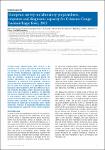European survey on laboratory preparedness, response and diagnostic capacity for Crimean-Congo haemorrhagic fever, 2012
Fernandez-García, M. D.
Negredo, A.
Papa, Anna
Mantke, Oliver Donoso
Niedrig, Matthias
Zeller, Hervé
Tenorio, Antonio
Franco, Leticia
Crimean-Congo haemorrhagic fever (CCHF) is an infectious viral disease that has (re-)emerged in the last decade in south-eastern Europe, and there is a risk for further geographical expansion to western Europe. Here we report the results of a survey covering 28 countries, conducted in 2012 among the member laboratories of the European Network for Diagnostics of ‘Imported’ Viral Diseases (ENIVD) to assess laboratory preparedness and response capacities for CCHF. The answers of 31 laboratories of the European region regarding CCHF case definition, training necessity, biosafety, quality assurance and diagnostic tests are presented. In addition, we identified the lack of a Regional Reference Expert Laboratory in or near endemic areas. Moreover, a comprehensive review of the biosafety level suitable to the reality of endemic areas is needed. These issues are challenges that should be addressed by European public health authorities. However, all respondent laboratories have suitable diagnostic capacities for the current situation.
Dateien zu dieser Publikation
Keine Lizenzangabe
Verwandte Publikationen
Anzeige der Publikationen mit ähnlichem Titel, Autor, Urheber und Thema.
-
2010-03-11ZeitschriftenartikelCrimean-Congo hemorrhagic fever in Europe: current situation calls for preparedness Maltezou, H. C.; Andonova, L.; Andraghetti, R.; Bouloy, M.; Ergonul, O.; Jongejan, F.; Kalvatchev, N.; Nichol, S.; Niedrig, Matthias; Platonov, A.; Thomson, Gail; Leitmeyer, Katrin; Zeller, HervéDuring the last decade Crimean-Congo hemorrhagic fever (CCHF) emerged and/or re-emerged in several Balkan countries, Turkey, southwestern regions of the Russian Federation, and the Ukraine, with considerable high fatality ...
-
1999-05-01ZeitschriftenartikelManagement und Kontrolle lebensbedrohender hochkontagiöser Infektionskrankheiten Fock, Rüdiger; Wirtz, Alfred; Peters, M.; Finke, E.-J.; Koch, U.; Scholz, D.; Niedrig, Matthias; Bußmann, H.; Fell, Gerhard; Bergmann, H.Ein Einschleppen lebensbedrohender und zugleich hochkontagiöser Infektionskrankheiten wie Lungenpest oder Ebola-Fieber nach Deutschland erscheint zur Zeit nicht sehr wahrscheinlich, ist aber grundsätzlich nicht auszuschließen. ...
-
2020-02-22ZeitschriftenartikelThe Utility of Human Immune System Mice for High-Containment Viral Hemorrhagic Fever Research Wozniak, David Maximilian; Lavender, Kerry J.; Prescott, Joseph; Spengler, Jessica R.Human immune system (HIS) mice are a subset of humanized mice that are generated by xenoengraftment of human immune cells or tissues and/or their progenitors into immunodeficient mice. Viral hemorrhagic fevers (VHFs) cause ...

